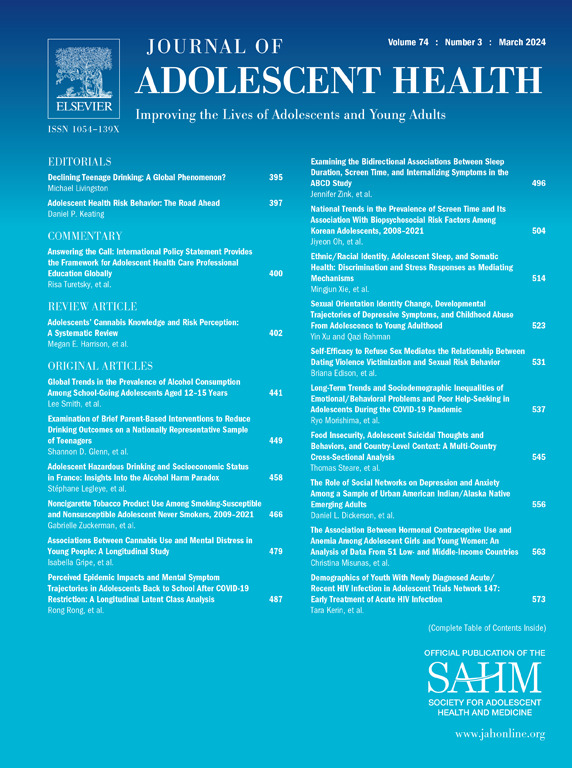National Coverage of Adolescent Opioid Overdose Prevention Content in Pediatrics Clerkships
IF 5.5
2区 医学
Q1 PEDIATRICS
引用次数: 0
Abstract
Purpose
Amidst rising fentanyl-related adolescent overdose deaths, pediatricians’ confidence in addressing opioid overdose risk and opioid use disorder is lacking, possibly due to inadequate training. Teaching opioid overdose prevention in the Pediatrics clerkship can address knowledge gaps and raise awareness of this public health emergency; however, it is necessary to assess its current coverage.
Methods
A cross-sectional web-based survey was administered to Pediatrics clerkship directors of U.S. allopathic and osteopathic medical schools in April 2024.
Results
Eighty-five of 189 schools responded (45%). Less than two-thirds (54 of 85) cover any related content, and none teach all essential areas, highlighting opportunities for curricular expansion. While topics like screening for opioid use and medications for opioid use disorder are occasionally addressed (41.2%, 9.4%), using the HEADSS (Home, Education, Activities, Drugs, Suicidality, Sex) assessment to address critical aspects like naloxone and fentanyl test kits remain largely untaught (4.8%, 3.7%).
Discussion
These findings underscore the need for curricular tools to enhance opioid overdose prevention education in Pediatrics clerkships.
全国覆盖青少年阿片类药物过量预防内容儿科办事员。
目的:随着芬太尼相关的青少年过量死亡人数的增加,儿科医生对解决阿片类药物过量风险和阿片类药物使用障碍缺乏信心,可能是由于培训不足。在儿科职员中开展预防阿片类药物过量的教学,可以弥补知识空白,提高对这一突发公共卫生事件的认识;然而,有必要评估其目前的覆盖范围。方法:于2024年4月对美国对抗疗法和整骨疗法医学院的儿科助理主任进行了一项基于网络的横断面调查。结果:189所学校中有85所回应(45%)。只有不到三分之二的学校(85所学校中的54所)涵盖了相关的内容,没有一所学校教授了所有的基本领域,这突出了课程扩展的机会。虽然偶尔会提到阿片类药物使用筛查和阿片类药物使用障碍的药物治疗等主题(41.2%,9.4%),但使用HEADSS(家庭,教育,活动,药物,自杀倾向,性)评估来解决纳洛酮和芬太尼检测试剂盒等关键方面的问题在很大程度上仍未被教授(4.8%,3.7%)。讨论:这些发现强调需要课程工具来加强儿科职员的阿片类药物过量预防教育。
本文章由计算机程序翻译,如有差异,请以英文原文为准。
求助全文
约1分钟内获得全文
求助全文
来源期刊

Journal of Adolescent Health
医学-公共卫生、环境卫生与职业卫生
CiteScore
10.40
自引率
3.90%
发文量
526
审稿时长
46 days
期刊介绍:
The Journal of Adolescent Health is a scientific publication dedicated to enhancing the health and well-being of adolescents and young adults. Our Journal covers a broad range of research topics, spanning from the basic biological and behavioral sciences to public health and policy. We welcome a variety of contributions, including original research papers, concise reports, literature reviews, clinical case reports, opinion pieces, and letters to the editor. We encourage professionals from diverse disciplines such as Anthropology, Education, Ethics, Global Health, Health Services Research, Law, Medicine, Mental and Behavioral Health, Nursing, Nutrition, Psychology, Public Health and Policy, Social Work, Sociology, and Youth Development to share their expertise and contribute to our mission of promoting adolescent health. Moreover, we value the voices of young individuals, family and community members, and healthcare professionals, and encourage them to submit poetry, personal narratives, images, and other creative works that provide unique insights into the experiences of adolescents and young adults. By combining scientific peer-reviewed research with creative expressions, our Journal aims to create a comprehensive understanding of the challenges and opportunities in adolescent and young adult health.
 求助内容:
求助内容: 应助结果提醒方式:
应助结果提醒方式:


